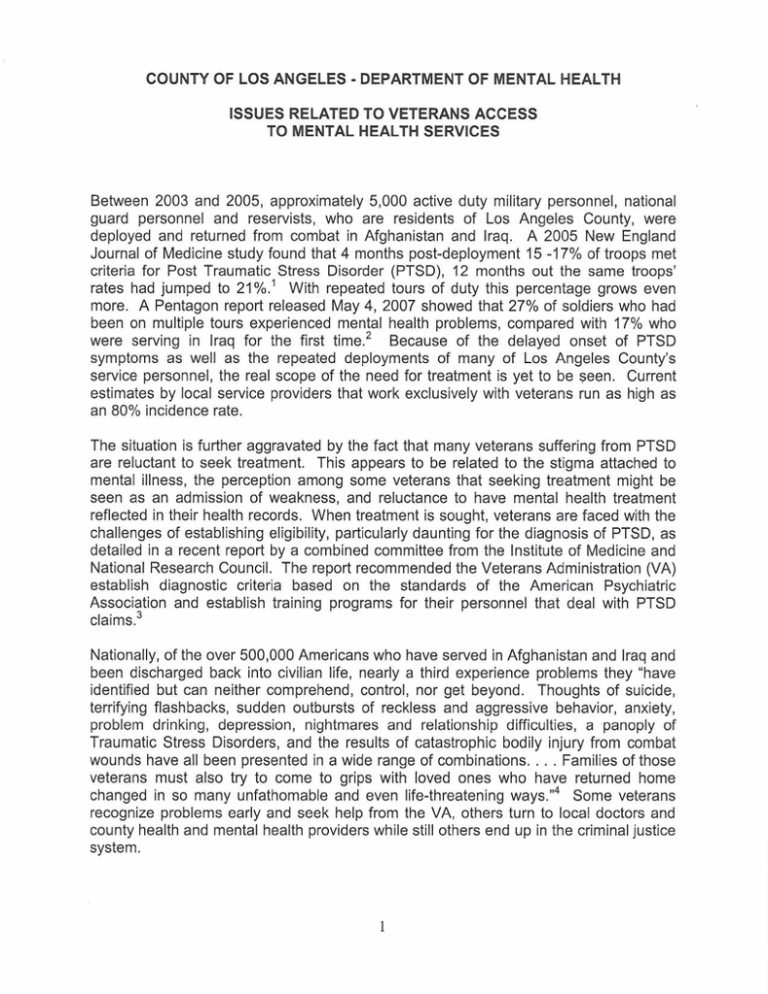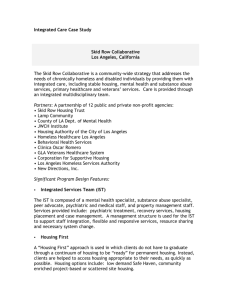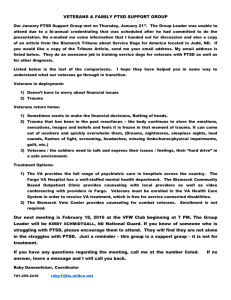-
advertisement

- COUNTY OF LOS ANGELES DEPARTMENT OF MENTAL HEALTH ISSUES RELATED TO VETERANS ACCESS TO MENTAL HEALTH SERVICES Between 2003 and 2005, approximately 5,000 active duty military personnel, national guard personnel and reservists, who are residents of Los Angeles County, were deployed and returned from combat in Afghanistan and Iraq. A 2005 New England Journal of Medicine study found that 4 months post-deployment 15 -1 7% of troops met criteria for Post Traumatic Stress Disorder (PTSD), 12 months out the same troops' rates had jumped to 21%.' With repeated tours of duty this percentage grows even more. A Pentagon report released May 4, 2007 showed that 27% of soldiers who had been on multiple tours experienced mental health problems, compared with 17% who were serving in lraq for the first time.* Because of the delayed onset of PTSD symptoms as well as the repeated deployments of many of Los Angeles County's service personnel, the real scope of the need for treatment is yet to be Seen. Current estimates by local service providers that work exclusively with veterans run as high as an 80% incidence rate. The situation is further aggravated by the fact that many veterans suffering from PTSD are reluctant to seek treatment. This appears to be related to the stigma attached to mental illness, the perception among some veterans that seeking treatment might be seen as an admission of weakness, and reluctance to have mental health treatment reflected in their health records. When treatment is sought, veterans are faced with the challenges of establishing eligibility, particularly daunting for the diagnosis of PTSD, as detailed in a recent report by a combined committee from the Institute of Medicine and National Research Council. The report recommended the Veterans Administration (VA) establish diagnostic criteria based on the standards of the American Psychiatric Association and establish training programs for their personnel that deal with PTSD c~aims.~ Nationally, of the over 500,000 Americans who have served in Afghanistan and Iraq and been discharged back into civilian life, nearly a third experience problems they "have identified but can neither comprehend, control, nor get beyond. Thoughts of suicide, terrifying flashbacks, sudden outbursts of reckless and aggressive behavior, anxiety, problem drinking, depression, nightmares and relationship difficulties, a panoply of Traumatic Stress Disorders, and the results of catastrophic bodily injury from combat wounds have all been presented in a wide range of combinations. . . . Families of those veterans must also try to come to grips with loved ones who have returned home changed in so many unfathomable and even life-threatening ways."' Some veterans recognize problems early and seek help from the VA, others turn to local doctors and county health and mental health providers while still others end up in the criminal justice system. Many veterans struggling with PTSD turn to drugs and alcohol, compounding their illness with a co-occurring disorder, making it even more difficult to obtain and maintain treatment that will enable them to regain their lives, and often leading to hornelessness. Those who do seek treatment, either through the VA or public mental health departments, often encounter significant obstacles related to establishing eligibility for services. The following stories, one from Los Angeles and the second from elsewhere in California, exemplify these challenges: John, age 24, was interviewed in the 10s Angeles County Jail mental health housing area by an outreach worker from a Community Based Organization that provides residential alcohol and drug treatment programs, including services for persons with co-occurring mental illness. John, a former serviceman, had served two tours of duty in Iraq. His mother reported he was his usual self upon return from his first deployment with no indication of a substance abuse problem. However, upon his return from his redeployment it was obvious that he had hit his breaking point and was "completely not there anymore". He suffered from PTSD and substance abuse disorder but received no comprehensive services for his co-occurring disorders. John left his home and family, traveling to California, He became homeless, wandering the streets of Santa Monica and Westwood and staying in cold weather shelters on winter nights. Eventually he was arrested for a drug offense. John was released from jail with the recommendation that he enter a residential program for his co-occurring disorder. He has not reported to the program and his whereabouts are unknown. "A.B. is a combat veteran who was a Navy Corpsman during Desert Storm, Suffering from combat-related PTSD, A.B. was discharged from the military without receiving a service-connected rating for his disability. He has spent the years since his military service in a continuous cycle of finding employment, only to lose it when the symptoms of his PTSD flared up and made it impossible to keep his job. As a result of losing his employment, he has often been homeless. "During his periods of employment, he had medical insurance that covered the costs of treatment and medications for his PTSD-related symptoms. When he lost his job two years ago, he also lost his health insurance, and with it, access to his medication. He applied for assistance from the county, but was denied because of his veteran status. He applied for treatment at the VA Mental Health Clinic at Mather, but was denied because he doesn't have a service-connected rating for a mental health condition. Without medication, he has not been able to stay employed at any one job long enough to qualify for employer-provided health care benefits, "He has applied for compensation from the VA, a'nd is trying to establish his service connected disability. However, this is a time-consuming process, and may take many months - or even years - to complete. Should he be successful, he would have access to mental health care from the VA. In the meantime, he is golng without medication or treatment. Should he be unsuccessful in proving his claim, he may spend the rest of his life caught in the gap between two bureau~racies."~ In September 2006 the Los Angeles County Department of Mental Health (LACDMH) received a Substance Abuse and Mental Health Services Administration (SAMHSA) grant award to better serve veterans with a serious mental illness. This grant was provided in response to a proposal developed collaboratively by the California Department of Mental Health, LACDMH, the California Association of Veterans Services Agencies (including two local agencies United States Veterans Initiative and New Directions) and the California Mental Health Directors' Association to pilot expanded, linked services in Los Angeles County for homeless veterans with mental illness, many of whom are also diagnosed with substance abuse disorders. The project provides outreach to homeless veterans with mental illness, referral for mental health treatment, case management, employment assistance and a linked residential service system that includes residential treatment for co-occurring disorders, transitional housing, and permanent affordable supported and independent housing. This collaborative project addresses the multiplicity of problems faced by our men and women returning from Afghanistan and lraq and can serve as a model for replication on a larger scale in Los Angeles County, should additional funding be available,. Footnotes 1 "Combat Duty in lraq and Afghanistan, Mental Health Problems and Barriers to Care" New England Journal of Medicine 351 :13-22 'Long tours in Iraq may be rnhefleld for mental health",Julian E. Barnes, Los Angeles Times, May 5, * 2007 "Better stress tests are urged for vetsn,Associated Press, Los Angeles Times, May 9, 2007 SAMHSA grant application submitted by the California Department of Mental Health, Los Angeles County Department of Mental Health, the California Association of Veterans Services Agencies and the California Mental Health Directors' Assocfatlon Statewide California Association of Veteran Service Agencies Position Paper, January 2006 S:\DMHASOCMSOCMSOCI\Waxman Report version 3.doc






